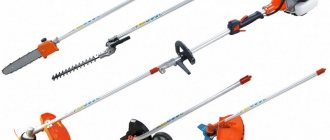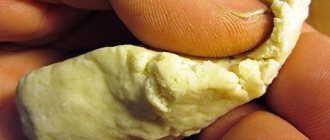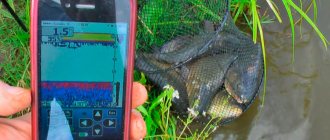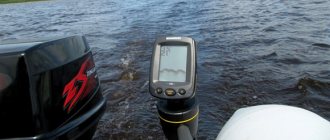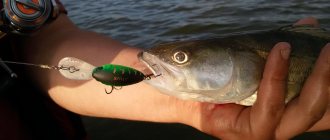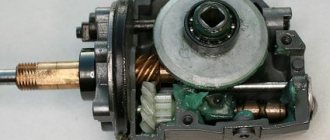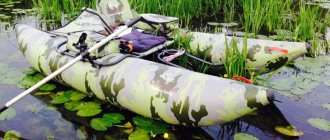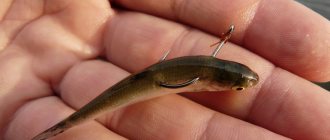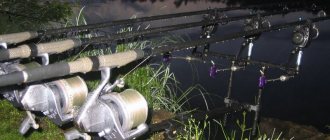Boat motors
March 22
How to install a boat motor
Having arrived at the river bank with a brand new outboard motor, the owner thinks about how to properly attach it to the stern of the boat. It would seem that there is nothing complicated about installing it yourself. The small power motor is easy to hang on the transom alone or with an assistant. The operating instructions supplied with the device describe in detail how this work is carried out. However, in order to achieve maximum speed and efficiency from a boat motor, it is necessary to spend time finding the optimal position of the motor on the transom of the boat.
Safety precautions when installing the motor
A boat motor is a heavy machine. Low-power devices weighing up to 20 kg are easy to install alone. It is better to install heavy motors weighing 30–50 kg on the transom of the boat together with an assistant in order not to break your back. To transport the motor from the car to the boat, a special cart for PLM is used.
All work on installing, setting up and moving the outboard motor is carried out with the engine turned off and the remote gas tank hose disconnected.
Do not smoke or use open flames near the boat while connecting the gas tank hoses and starting the boat engine.
Advantages and disadvantages
If we compare an electric motor with fuel types of devices, we can highlight the following advantages:
- Low noise and vibration effect. Compared to a conventional engine, you will feel truly at one with nature, you will be able to relax and unwind while listening to the lapping of the waves, and most importantly, you will be able to silently approach the fish.
- High mobility. The electric motor is quite easy to dismantle and install back.
- Simplified operation. This device does not require changing oil, spark plugs, lubricants or similar rough work.
- Caring for the environment. The electric motor does not emit toxic emissions, and fuel does not leak into the aquatic environment.
Among the disadvantages you should pay attention to:
- Low power. You will have to forget about the high speed of movement, although, recently, more advanced electric motors have appeared that are not inferior in speed to other types.
- Duration of the cruise. The batteries on most electric motors drain quickly. There are two options for solving this problem: either carry spare batteries with you, or invest in a more expensive device.
If we compare electric motors with each other, then each type has both its advantages and disadvantages. The choice is yours.
Let's look at each type of electric motor in more detail, and also pay attention to their pros and cons.
Bow electric motor
The advantages of the bow electric motor include:
- high precision maneuvers; the vessel is not pushed through the water, but is pulled by a motor;
- wide selection of control devices;
- the presence of additional functions, such as GPS.
Among the disadvantages it should be noted:
- price, which is determined by the complexity of production;
- can only be installed on a hard surface, so this option is not suitable for boats with a soft bow;
- massive, takes up a lot of space on the tank.
Outboard motor
The advantages of an outboard electric motor include:
- Easy installation using threaded clamps.
- Attractive price.
- Compactness.
- High mobility, easy to dismantle and transport.
The disadvantages include:
How to catch more fish?
I have been active fishing for quite some time and have found many ways to improve the bite. And here are the most effective:
- Bite activator. Attracts fish in cold and warm water with the help of pheromones included in the composition and stimulates its appetite. It’s a pity that Rosprirodnadzor wants to impose a ban on its sale.
- More sensitive gear. Reviews and instructions for other types of gear can be found on the pages of my website.
- Lures using pheromones.
You can get the rest of the secrets of successful fishing for free by reading our other articles on the site.
- Lack of precision in maneuvers. To get used to changing course, you need to have significant practice. Control is usually carried out using a tiller.
- Lack of additional functions and special features.
Mounted electric motor
The advantage of this model is its compactness, but the disadvantages include: complexity in management, unreasonably high cost, lack of any additional functions.
Installing the motor on the boat transom
After the boat is fully inflated, the motor is hung on the transom. The newly purchased motor is hung in the middle of the transom and secured with clamps from the suspension system. The clamps are tightened all the way with the same force. After installation, the motor is additionally tied to the transom with a safety rope.
For reliability, the attachment of the motor to the transom is additionally checked twice: after it warms up and 5 - 10 minutes after the vessel starts moving. If necessary, tighten the clamps more tightly.
Attaching the motor to the boat
The power unit is installed using transom brackets and clamps. The tightening forces of the clamps are equal, up to the stop. In most motorboat models, the power unit is strengthened taking into account the keel line.
At the end of installation, it is important to check the reliability of fastening the power structure to the boat. The strength of the connection must also be monitored during operation of the structure on the move. Vibration weakens the fastener. This phenomenon often occurs when loads increase: sharp turns, hitting a sandbank, overcoming a large wave. The best outcome is if the motor moves slightly from its original location.
In the case of self-unscrewing, it is possible that the power unit will be held in the boat only by the transom or a safety cable (in models with a safety device).
General rules and recommendations will allow you to securely secure the motor. Of course, there are cases where the optimal position of the power unit is the result of many hours of experimentation. In such cases, the solution is to seek help from specialists. At the service center, the buyer will be advised of combinations with the predicted result. For complex structures, the mounting location for the unit will be selected experimentally.
Horizontal motor position adjustment
Correct installation of the motor on the transom of the boat increases the speed and controllability of the vessel and saves fuel. According to the instructions, the outboard motor is installed on the center of the transom. Standard installation of the motor is not difficult, but in order to get maximum speed and efficiency from the motor, it is necessary to find the optimal position of the device at the stern of the vessel.
While the motor is running, the propeller rotates and creates a vortex flow behind the stern of the boat, shifting the boat from its straight trajectory. To compensate for propeller torque, the motor can be moved slightly to the starboard side of the boat. Shifting the position of the motor by 30 - 50 mm relative to the longitudinal center of the boat increases the stability and controllability of the vessel. The length of the offset depends on the bottom profile of the boat:
• for models with a convex V-shaped bottom, the motor is shifted by 5 cm;
• for boats with a flat bottom, the motor on the transom is shifted by 3 cm.
On boats of well-known brands, the profile of the stern and bottom compensates for the vortex flow from the propeller, so the outboard motor is installed strictly in the center of the transom. On boats in the mid-price category, to increase speed, improve ship controllability and save fuel, it is necessary to adjust the horizontal position of the motor on the transom.
Motor mounting height
The motor is secured taking into account the position of the anti-cavitation plate located on the deadwood. Depending on the model, the approximate level of the screw location is 0-5 cm below the bottom. The exact parameters are determined:
- experimentally: testing control techniques on the go when changing the mounting height within 0-50 cm;
- recommendation of a specialist in the sale, repair or maintenance of specific models of motors and boats.
An excessively high installation of the motor unit provokes the formation of a large number of gas bubbles in the upper layer of water. The process is called cavitation. Outwardly it resembles boiling water when heated. The screw rotates in a more rarefied environment: a mixture of water and air. The engine speed increases beyond the permissible limit, and it overheats. The best outcome is that the safety valve trips.
A low engine position increases water resistance, reduces speed, and contributes to wasted power. The worst outcome is loss of control of the vessel.
Adjusting the engine angle
Correctly setting the angle of inclination of the outboard motor relative to the stern of the vessel increases the speed of the boat and saves fuel. The position of the deadwood relative to the boat transom depends on the following factors:
• the structure of the vessel, its contours and stern;
• propeller pitch;
• motor power;
• number of passengers and weight of cargo in the boat;
• current speed;
• wind speed and direction, wave heights.
To change the inclination of the deadwood of a boat motor relative to the stern of the boat, there are holes in the outboard bracket of the motor into which a pin is inserted. Moving the pin into the adjacent hole changes the angle of the motor by 3 - 4°.
To adjust the angle of the motor, stop the engine, pull out the pin, move the brackets relative to each other, and insert the pin back. They start the engine and swim a section of the route at different speeds. After testing, the motor position adjustment is repeated.
If the boat motor is set too far from the transom, the torque from the propeller lifts the bow of the boat and sinks the stern. The speed of the boat increases, it goes into planing mode faster and easier, and controllability decreases.
With a slight deviation of the deadwood from the stern of the boat, there is no bow-pushing effect, the boat goes smoothly, and fuel consumption increases.
With a negative engine tilt angle, the boat begins to bury its nose into the waves, speed and controllability decrease.
How to properly install an outboard motor.
All outboard motors are equipped with standard attachment points to the boat - transom brackets. The outboard motor is mounted on the transom of the boat clearly in the center, using a transom bracket and clamps. The clamps should be screwed in all the way and should be checked periodically while sailing, as vibration from the boat can cause the clamps to become loose. If the outboard motor is poorly secured to the transom, it will move when moving, which will lead to reduced controllability and can cause a dangerous situation on the water. Make sure to tighten the transom clamps well and be sure to check them periodically while sailing.
If your outboard motor comes with a safety rope, be sure to attach the safety rope to the outboard transom bracket and secure the other end to the boat. This will protect you from losing the motor if the fastenings become loose, when the boat overturns and in other extremely dangerous situations.
Check the boat's buoyancy at rest with maximum load by conducting water tests. The water level should be below the outlet of the muffler nozzle; when the outboard motor is not running, water should not enter the hole of the muffler nozzle.
Do not install an outboard motor that is too powerful. There are recommendations from the boat manufacturer, be sure to read and follow them. Overloading a motor boat leads to loss of stability.
Improper outboard motor installation, off-center transom installation, loose mounting, or improper height adjustment can result in poor handling, loss of control, and the possibility of fire.
The outboard motor is installed along the center line of the boat (this is the so-called keel line). After installing the motor, check that the boat is well balanced. If the balance is not good enough, the motorboat will have poor handling. When installing the engine on keelless and asymmetrical boats, consult the boat manufacturer.
The angle of deviation of the waterline plane from the axis of the motor propeller should be minimal; it is set to achieve minimal water resistance.
The height of the motor mounting also influences the water resistance when moving. If the motor is installed too high, the possibility of cavitation arises - the propeller rotates in a water-air environment, this leads to a decrease in the speed of the boat, increased engine speed, and overheating of the motor. If the motor is installed too low, water resistance increases, which means an inevitable loss of power. The motor should be installed so that the distance from the bottom of the boat to the anti-cavitation plate of the motor is 0-1 inch (0-25mm).
The optimal motor mounting height is determined experimentally. A test boat ride will allow you to determine the best installation height. Don't forget to check with your boat manufacturer.
Trimming (adjusting trim).
Trimming allows you to adjust the position of the boat in relation to the surface of the water. Correct trim adjustment saves fuel consumption and helps avoid power losses. The trim of the boat depends on the type of boat itself, the motor and the propeller. The trim should be selected depending on the loading of the boat, weather conditions and the speed of the vessel.
Setting an excessively large trim (positive or negative) makes the boat unstable while moving and reduces controllability. If you feel a decrease in the stability or controllability of the boat while moving, check and adjust the trim.
When stationary with a load and a motor, a motor boat has a stable and stable state with a trim angle (the angle between the water surface and the keel line) of 3-5 degrees.
If the trim angle is too large, the bow of the boat will be raised up relative to the surface of the water. With such a large trim angle, the boat will constantly jump out of the water, which will lead to poor stability and controllability. This is a dangerous position that could cause the boat to capsize.
With a negative trim angle, the bow of the boat sticks into the surface of the water. At this angle, the load on the motor increases, the speed decreases, and the boat becomes unstable and poorly controlled.
